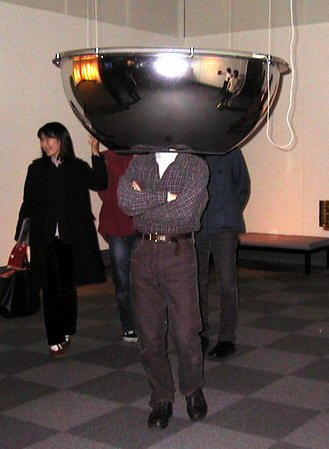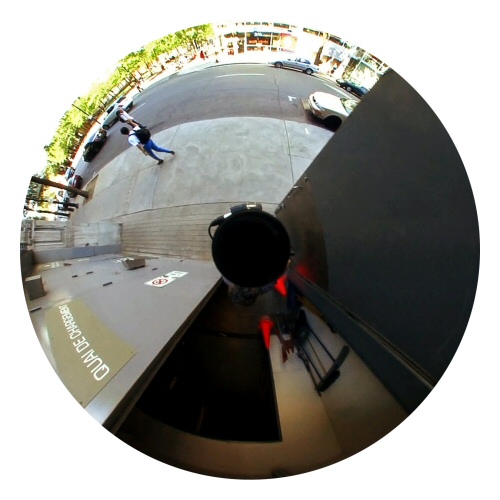Please wait a few moments while we process your request

Luc Courchesne
The Visitor: Living by Numbers
It is a striking image: a human form standing inside a metal structure, the person's head concealed under an inverted dome that reflects the surrounding space. The computer that sits on a pedestal near the installation displays what the "visitor" sees inside the dome. The work's title is itself symbolic, for the transformation of spectator to visitor is clearly the running thread in the artist's work. The word evokes the movement and interaction involved in paying a visit to someone. From the beginning of his career, the artist, in striving to intensify the presence of his works, its protagonists and its "visitors," has focused on the creative possibilities for socialization offered by new technologies. We visit with Marie in Portrait One (1990) and with a range of individuals in Family Portrait (1993) and Hall of Shadows (1996). This ongoing interest in socialization grows more pronounced from one work to the next as the installations themselves become increasingly complex and advanced in their development and presentation mode. With The Visitor, interaction takes place through voice recognition. Unlike most interactive works, here there is no need for manipulation. And while the principle of interactivity remains at the core of Courchesne's practice, one feels a progression towards works that are more and more immersive. In Landscape One, the body of the participant was surrounded by images; with The Visitor, images encircle the head. And the strategy is efficient, for when all spatial references are removed, the visitor is plunged into the image – and the work becomes immersion defined.
The Visitor draws on the research conducted by Courchesne in image projection, which led to the creation of his Panoscope 360º, a device that allows a 360º panoramic image to be projected using a single video channel. The system is a direct descendant of the panorama invented and patented in 1787 by Irish painter Robert Barker.
"Like a sculptor, I am interested in form. The means I am using – computers, video, space – allow me to take upon the challenges associated with giving form in novel ways as I am also trying to include the visitors' existence into the work's inner structures." (1)
Without question, this existence is paramount, for the work is dependent upon the visitor's whims and choices to define itself and reveal its full potential.
Once the dome is adjusted to the correct height, visitors are plunged into the Japanese countryside. They are turned north by saying the number twelve (in English), directed east with number three, south with six, and west with nine. During their virtual excursion, visitors arrive at a shelter, where they meet eight people, four men and four women of varying origins and occupations, seated around a table. The visitors use numbers to communicate and get to know these individuals, thus initiating a type of socialization and finding their place within the group.
The Visitor: Living by Numbers draws its inspiration from both a film and a dream. The film is Theorema, by Pier Paolo Pasolini, and like Terence Stamp in the film, visitors seek to establish a relationship with their hosts. But the psychological upheaval in Theorema translates into physical upheaval in The Visitor – an earthquake forces the inhabitants to flee. In the dream, which Courchesne's daughter had when she was 10 years old, they fled a catastrophe, taking bottles with them. In The Visitor, these become bottles of sake. The visitor must make a choice: to leave the house with the group and seek other shelter (as in the dream) or to leave the inhabitants to fend for themselves (as in Theorema). Throughout the visit, varying scenarios are offered.
The Visitor is an example of what has been known since the 1960s as expanded cinema, in that it extends well beyond the frame in terms of format and the content and syntax associated with traditional narration. Courchesne cites the impact that the films of Michael Snow, Hollis Frampton, Stan Brakhage and Robert Frank have had on his artistic development. All of these experimental filmmakers broke with conventional cinema by rejecting or deconstructing narration in favour of reflexive strategies (reflection on the medium itself). The search for new avenues of structure and form has often involved incorporating other practices (sculpture in the case of Snow, painting for Brakhage, photography with Frank, and language for Snow and Frampton). Responsive to the experimentation of these artists, Courchesne has also used photography, sculpture, film and design in the creation of his works. Moreover, he maintains that it is inappropriate to associate narration with the construction and experience of an interactive work that is created as a portal. Any narration involved should come not from the work itself, but rather from the visitor following his or her experience.
The Visitor draws on the research conducted by Courchesne in image projection, which led to the creation of his Panoscope 360º, a device that allows a 360º panoramic image to be projected using a single video channel. The system is a direct descendant of the panorama invented and patented in 1787 by Irish painter Robert Barker.
"Like a sculptor, I am interested in form. The means I am using – computers, video, space – allow me to take upon the challenges associated with giving form in novel ways as I am also trying to include the visitors' existence into the work's inner structures." (1)
Without question, this existence is paramount, for the work is dependent upon the visitor's whims and choices to define itself and reveal its full potential.
Once the dome is adjusted to the correct height, visitors are plunged into the Japanese countryside. They are turned north by saying the number twelve (in English), directed east with number three, south with six, and west with nine. During their virtual excursion, visitors arrive at a shelter, where they meet eight people, four men and four women of varying origins and occupations, seated around a table. The visitors use numbers to communicate and get to know these individuals, thus initiating a type of socialization and finding their place within the group.
The Visitor: Living by Numbers draws its inspiration from both a film and a dream. The film is Theorema, by Pier Paolo Pasolini, and like Terence Stamp in the film, visitors seek to establish a relationship with their hosts. But the psychological upheaval in Theorema translates into physical upheaval in The Visitor – an earthquake forces the inhabitants to flee. In the dream, which Courchesne's daughter had when she was 10 years old, they fled a catastrophe, taking bottles with them. In The Visitor, these become bottles of sake. The visitor must make a choice: to leave the house with the group and seek other shelter (as in the dream) or to leave the inhabitants to fend for themselves (as in Theorema). Throughout the visit, varying scenarios are offered.
The Visitor is an example of what has been known since the 1960s as expanded cinema, in that it extends well beyond the frame in terms of format and the content and syntax associated with traditional narration. Courchesne cites the impact that the films of Michael Snow, Hollis Frampton, Stan Brakhage and Robert Frank have had on his artistic development. All of these experimental filmmakers broke with conventional cinema by rejecting or deconstructing narration in favour of reflexive strategies (reflection on the medium itself). The search for new avenues of structure and form has often involved incorporating other practices (sculpture in the case of Snow, painting for Brakhage, photography with Frank, and language for Snow and Frampton). Responsive to the experimentation of these artists, Courchesne has also used photography, sculpture, film and design in the creation of his works. Moreover, he maintains that it is inappropriate to associate narration with the construction and experience of an interactive work that is created as a portal. Any narration involved should come not from the work itself, but rather from the visitor following his or her experience.
Jacques Perron © 2005 FDL
(1) This quote was taken from an e-mail conversation between Luc Courchesne and Victoria Lynn, curator of the Space Odysseys exhibition at the Art Gallery of New South Wales (Sydney, Australia), where the work premiered in August 2001.
Related pages:
 Luc Courchesne, Portrait One
Luc Courchesne, Portrait OnePortrait One is a fictional work and a framed encounter with a character.
External links:
Panoscope 360º :
http://www.panoscope360.com
http://www.panoscope360.com
Luc Courchesne:
http://www.courchel.net/
http://www.courchel.net/







